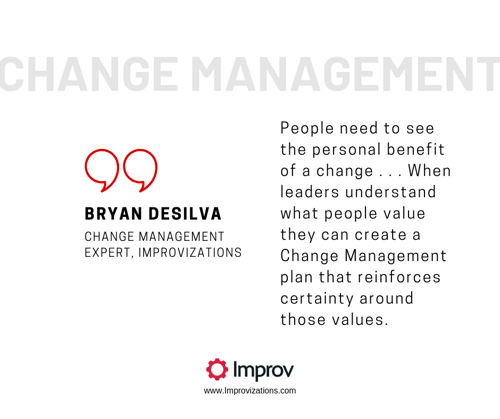

(Editor’s note: This is part two of our series on specific strategies to help your team embrace change in the workplace. Read part one, here).
You’re looking forward to the new software upgrade; as a member of upper management, you’re ecstatic about it actually. There’s no doubt that once the change is adopted enterprise-wide, it will reduce labor costs, alleviate compliance worries, and boost the company’s bottom line.All of these are solid business objectives, right? So why would anyone resist progress or rebel against such positive change?
Because in business there’s nothing more personal than change.
And, underestimating the intricacies of change and how to implement it can make or break employee adoption and any shot at those awesome business goals.
Critical to successful change is adoption. With strong employee adoption, your upgrade plans soar but without it, you’re stuck at first base indefinitely. Your idea of change and your staff and workforce’s idea of change can be oceans apart, which is where understanding the importance of a solid Change Management strategy becomes critical.
The change you are hoping to make can be significant like a workforce management software implementation or upgrade that touches every person in the enterprise. Or it can be a smaller change, such as a process change.
Whatever the scope of the proposed change, the first step is diagnosing the sources of resistance and meeting those very personal realities head on with some tangible solutions.
5 Pain Points of Change
-
Loss of control. To those on the receiving end, an organizational change signals a loss of control over territory, influence, or power. Even though we all go through big and small changes on a daily basis most of that change can be approached on our terms, in our time, in our way. Facing change in the workplace, however, comes from an outside source and can trigger personal, emotional, and financial concerns — all touchy stuff.
Strategy: Invite key stakeholders in to the change planning process. Giving people a sense of ownership helps build and restore a sense of security and control moving into a proposed change
-
Fear of judgment. When a change is introduced, it means a decision has been made to depart from the former way of doing things. That means any stakeholder that was a part of or responsible for a past software implementation will feel defensive about the reasons it worked or didn’t work. Whether it’s factual or not, departing from the past can feel like a personal failure or an embarrassment for some people.
Strategy: Even though an upgrade signals improvement, it doesn’t cancel out the many steps that contributed to the team’s current successes. Change doesn’t have to be viewed as black and white or good and bad. Rather, every step — past, present, and future — is critical in the bigger journey. In tandem with introducing change, clearly communicate the wins of the past and recognize the key decision makers and milestones that brought the team this far. Celebrating, letting go, and moving on can be a healthy, exciting experience if handled properly through a strong Change Management strategy.
-
Fear of the unknown. Who hasn’t felt fear before moving something new? When change is introduced, people feel uncertain, fearful, and threatened. Change can rock the skills they’ve mastered, the wins they’ve scored, and the status and influence they’ve built around them that help them feel significant to the team and secure in their job.
“People need to see the personal benefit of a change and their specific role in it before they get behind it,” says Bryan deSilva, Change Management expert and managing director at Improvizations. “When leaders understand what people value they can create a plan that reinforces certainty around those values.
Strategy: Communicate, communicate, communicate. By setting up a clear change management strategy with clear and simple steps and timetables, you can alleviate fear along with the resistance and rumor mills that spring from fear.

-
Fear of failure. As fast as technology moves today, change has become the norm. Even so, that doesn’t mean everyone adapts to new technology at the same pace. With any change, there will be those who are paralyzed by their lack of ability to understand and fully implement the new technology — and they rarely will vocalize this fear. Rather, they will suffer in silence and that fear may play out in other ways such as undermining, sabotaging, gossiping, and outright rebellion.
Strategy: Clear communication around a strong training program is the answer to this adoption hurdle. Helping unsure employees see their training path clearly builds confidence and is a significant part of a strong Change Management plan.
-
Fear of the past. Many people associate change with pain because of an organization’s failure to successfully implement a change in the past. Politics, poor communication, layoffs, and internal conflict may have been part of an organization’s past.
Says deSilva, “Talk with team members who have been at the organization forever (the ones who know where the bodies are hidden) and really dig deep to best understand why the culture is the way it is, and why the history happened the way it did. This is your chance to unearth any reason at all your project might fail.”
Strategy: Do the work required before crafting a change strategy. Get honest feedback and insight before introducing change. Get the whole picture — the good, the bad, and the downright awful — so you avoid mistakes of the past. Pull resistors into the circle by crafting a change management process that is transparent, honest, and honors the company’s unique individuals, history, and it’s current culture.
Hey, Let's Talk Change Management
Are you implementing a new WFM platform? Are you contemplating an upgrade to an existing platform? Improv’s Change Management experts will help you develop custom training programs that engage your employees in ways that speak uniquely to your culture.
The Improvizations team of creative Kronos consultants can help with all the issues that arise (and often sabotage) the implementation process. Our Change Management professionals will link arms with you to champion a successful implementation or upgrade.
Let's talk today!

.png)
.png)
.png)
Comments